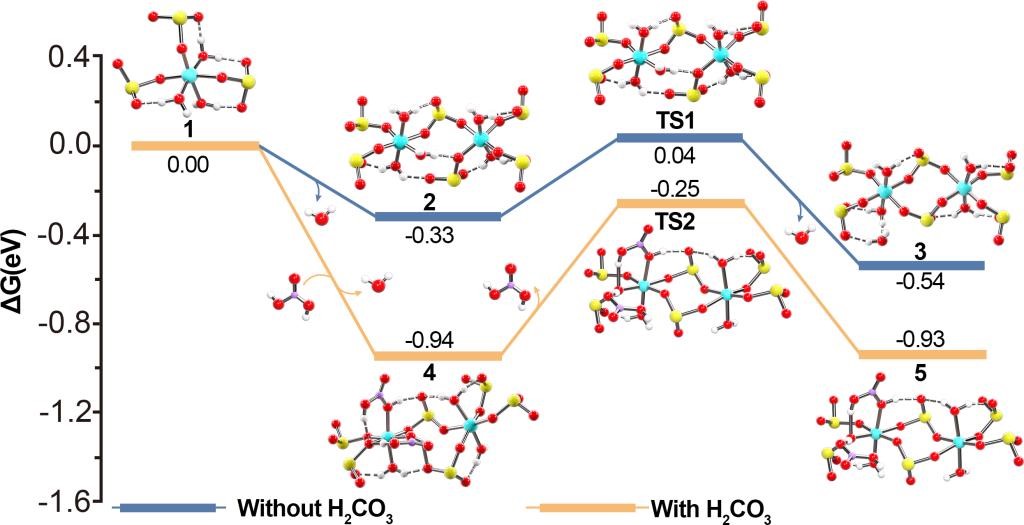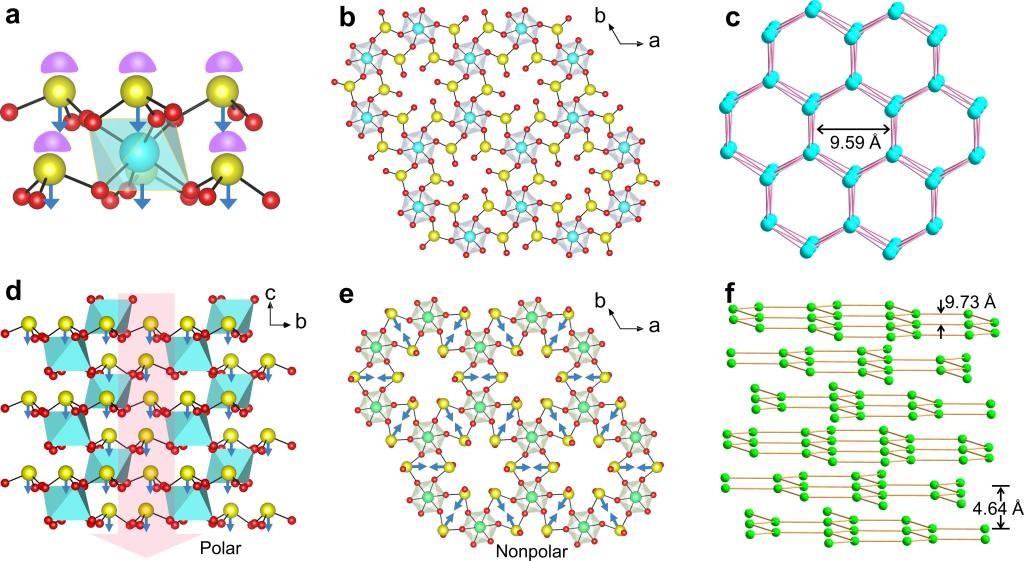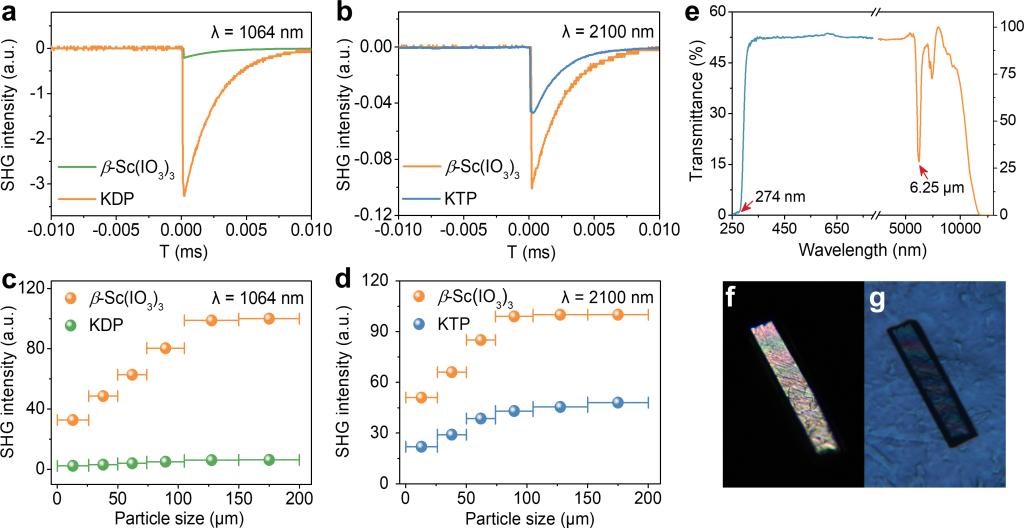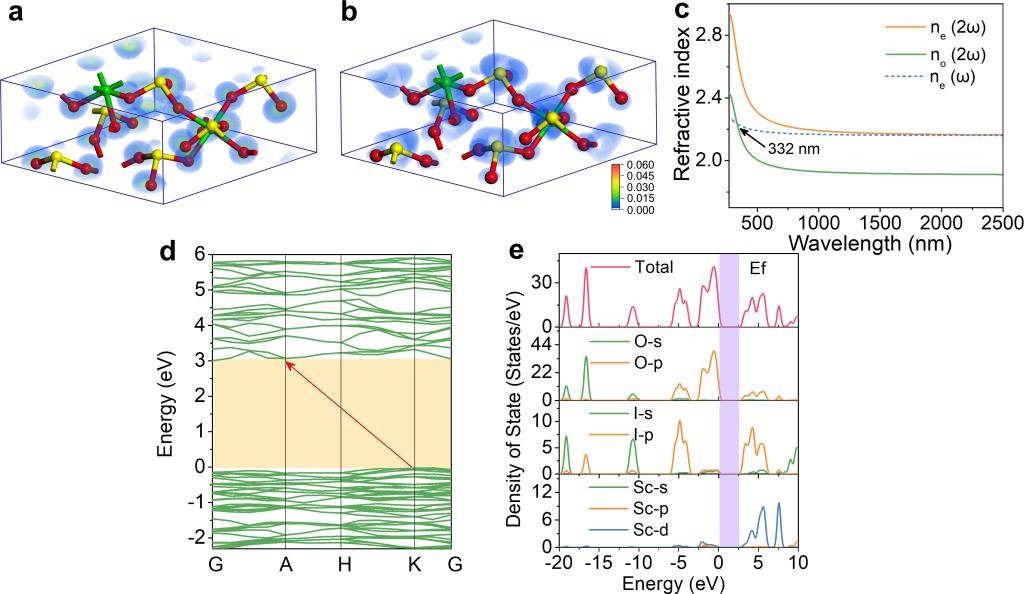Second-order nonlinear optical crystals can realize tunable lasers that are difficult to obtain through frequency conversion. As the vital part of solid-state lasers, they are widely used in military (e.g. laser communication and infrared countermeasure) and civil fields (e.g. infrared telemetry and medical diagnosis). Metal iodate crystal materials have strong second-harmonic generation responses, wide optical transmission window and optical band gap, and high laser damage threshold, which play an important role in second-order nonlinear optical crystal materials. Most of the reported iodate crystals are crystallized in centrosymmetric clusters in space, resulting in no second-harmonic generation responses. Therefore, exploring the design and synthesis of iodate crystals with noncentrosymmetric structure, strong second-harmonic generation responses and wide optical band gaps is a challenging scientific and technological problem in the field of second-order nonlinear optical crystal materials.

The research team discovered strong second-harmonic generation responses
The research team of Professor ZHANG Chi from the School of Chemical Science and Engineering of Tongji University who is a member of the European Academy of Sciences, revealed for the first time the influence of reaction promoter on the crystallization and nucleation of polycrystalline rare earth iodate crystalline materials based on the polycrystalline of iodate. They designed and created a mid-infrared second-order nonlinear optical crystal material with strong frequency doubling response and broadband gap β-Sc(IO3)3. A research paper on Additive Triggered Polar Polymer Formation: β-Sc(IO3)3, a Promising Next Generation Mid-Infrared Nonlinear Optical Material, was published online in Angelwandte Chemie International Edition, 2022, 61 (36), e202208514 on August 26.

The researchers designed and created a mid-infrared second-order nonlinear optical crystal material with strong frequency doubling response and broadband gap β-Sc(IO3)3.
In 2002, Professor Andrew L. Hector of the University of Southampton, UK first discovered and reported the crystal form of the rare earth scandium iodate α-Sc(IO3)3 stable phase. However, the single crystal X-ray diffraction study showed that it has a nonpolar centrosymmetric structure, in which the nonlinear optical active units [IO3] - anions as solitary pairs are arranged in a way that completely counteracts each other, resulting in no optical second-harmonic generation responses of the molecules. In this study, ZHANG Chi's research team proposed a reaction promoter inducing the formation of polycrystalline iodate. As a nucleating "catalyst", the appropriate reaction promoter can be "seeded" into the reaction solution to adjust selectively the nucleating barrier of polycrystalline iodate, and finally achieve "controllable" crystal nucleation. In the process of crystal nucleation and growth, different interactions may occur between the crystal nucleus and the reaction promoter, such as binding and dissociation processes, which may lead to the reassembly and arrangement of iodate groups, thus forming a polar crystalline structure, which is conducive to the superposition of the micro second order polarizability. The thermodynamic and kinetic processes of the change induced by the reaction promoter can trigger the crystallization of metastable iodate. Based on the strategy of this reaction promoter to trigger the synthesis of noncentral iodate, a rare earth scandium iodate with noncentrosymmetric metastable phase was successfully created: β- Sc(IO3)3 crystal.

ZHANG’s team proposed additive- triggered polar polymer formation
The research team clarified through application of the density function theory that the interaction between reaction promoter and crystal nucleation precursors is the key to achieve noncentrosymmetric structure selectivity. The free energy of carbonic acid and scandium ion combination is higher than that of water and scandium ion, but lower than that of iodate and scandium ion. From the perspective of reaction thermodynamics, the decarbonation process in the noncardiac precursor is a dynamic equilibrium process, and the noncardiac precursor will not spontaneously form the central precursor. From the perspective of reaction kinetics, the free energy barrier of noncardiac precursor forming central precursor is high, which increases the difficulty of decarbonation in non-central phase. Therefore, carbonic acid can prevent transformation from noncardiac precursor β-Sc(IO3)3 to central phase precursor α-Sc(IO3)3, and promotes maximally the formation of noncardiac precursor β- Sc(IO3)3. The X-ray diffraction analysis and frequency doubling density analysis of single crystal structure show that the reaction promoter induce the optimal arrangement of iodate radical in the structure, and these nonlinear optical active groups produce superimposed second-order micro polarizability, which makes the material present strong second-harmonic generation responses and wide band gap. Experimental research shows that the rare earth iodate crystal β-Sc(IO3)3 has strong second-harmonic generation responses (16.0 × KDP @ 1064 nm,2.2 × AGS @ 2100 nm) and wide optical band gap (4.52 eV). β-Sc(IO3)3 also shows a wide optical transmission range (2.5~6.25 μm), appropriate birefringence (0.219 @ 546 nm), and excellent stability, which is an excellent mid infrared second-order nonlinear optical crystal material. This research is of great significance to the exploration and design of mid-infrared second-order nonlinear optical crystals in iodate system.

The interaction between reaction promoter and crystal nucleation precursors is the key to achieve noncentrosymmetric structure selectivity.
The research work was supported by NSFC, innovation teams of the Ministry of Science and Technology and the Science and Technology Innovation Plan of the Shanghai Education Commission. ZHANG Chi is the corresponding author of the paper, associate professors WU Chao and WEI Guangfeng are the co-first authors of the paper. Master’s student XU Qinke synthesized metastable crystal materials, and Professor HUANG Zhipeng participated in the relevant research work.
Paper link:https://onlinelibrary.wiley.com/doi/10.1002/anie.202208514